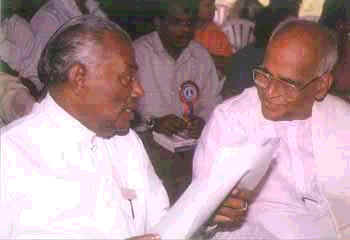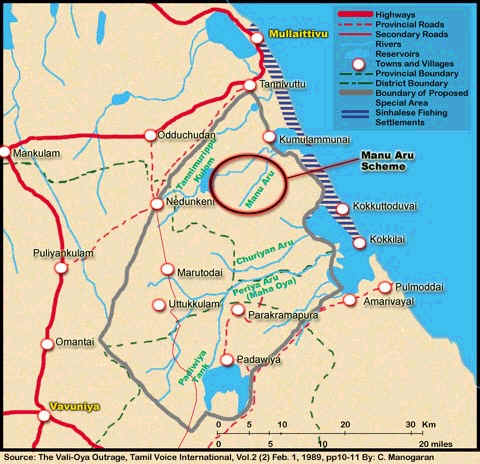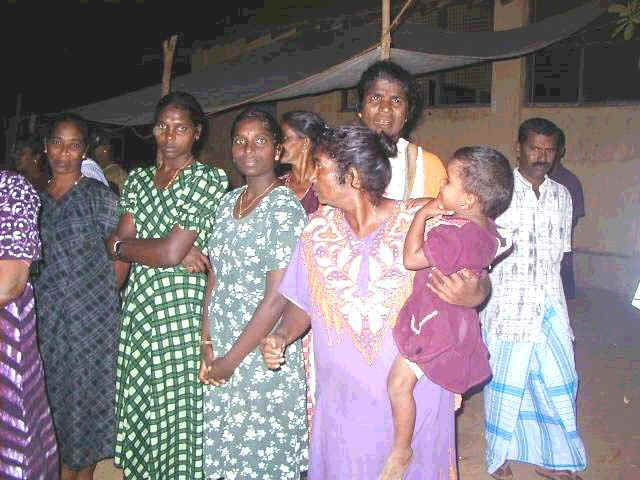 (map
courtesy
TamilNet)
(map
courtesy
TamilNet)by T. Sabaratnam
(Volume 2)
On the Sly
The Yan Oya settlement that would break the territorial contiguity of Tamil Eelam between Trincomalee and Mullaitivu districts was started on the sly. The planners of the project wanted to settle Sinhalese along the Yan Oya (river) which flows into the sea north of Trincomalee at a place called Thiriyaya. The plan was to settle farmers along the Yan Oya basin and fishermen along the Mullaitivu coastline.
Mahaweli Authority Chairman N. G. P. Panditharatne, realizing that the Maduru Oya settlement was collapsing, sent Karunatilleke to Vavuniya to locate suitable places to settle the evicted farmers. Karunatilleke visited Vavuniya in the first week of October 1983 and met Police Superintendent Arthur Herath and the Additional Government Agent of Vavuniya, a Sinhalese. They took Karunatilleke to Nedunkerni, in the Mullaitivu district, and showed him the vast expanse of flourishing agricultural land.
 (map
courtesy
TamilNet)
(map
courtesy
TamilNet)
Most of that area was dotted with traditional Tamil farming villages interspersed with small and large farms owned by Tamils or held on long lease by Tamil-owned business enterprises. The lease for 99 years was granted by the government in 1965. The extent of individual holdings varied from ten to fifty acres. Business concerns held large farms and 16 of them were a thousand acres and more. Among the large farms were: Navalar farm, Ceylon Theatres farm, Kent farm, Railway Group Farm, Postmaster Group Farm and Dollar Farm.
Dollar and Kent Farms were talked about because of their successful experiment in rehabilitating Indian Tamil refugee families chased out from the hill country by Sinhalese mobs during the 1977 communal violence. Herath showed Karunatilleke those prosperous farms and told him that the settlers were terrorists or were harbouring terrorists, especially those of the EPRLF. He told Karunatilleke that these farms were obstacles to the northward expansion of Sinhala colonization in Padavia. Karunatilleke submitted a report to the Mahaweli Ministry on 12 October.
The following was his recommendation:
I strongly request these illicit settlements and anti-national activities be probed into and suitable action taken. Their existence will not only prevent the expansion of the habitat of the people living in this area on a planned basis, but also would pose a threat to national security.
The
Mahaweli
Ministry
could
not
act
on
that
report
as
Jayewardene,
who
was
annoyed
with
his
‘pet’,
Gamini
Dissanayake,
for
messing
up
the
Maduru
Oya
settlement,
had
handed
over
the
task
of
implementing
the
Yan
Oya
project
to
Lalith
Athulathmudali,
who
commenced
his
work
on
the
sly.
(Yan Oya north of Trincomalee)
Athulathmudali was appointed Minister of National Security and Deputy Minister of Defence on 23 March 1984. He visited Mankulam in the first week of May in the pretext of opening an agricultural market (Govi Pola), a scheme he was then promoting to help agriculturalists get better prices for their products. As the one who covered his Trade and Commerce Ministry, I went to Mankulam with the media group. Lalith Athulathmudali and Gamini Dissanayake were very clever and knew the art of hogging newspaper headlines. Reporters relished covering them because they knew they would get good lead stories. I was fortunate to cover both.
At the risk of breaking the continuity of the narrative, I wish to record here what Lalith Athulathmudali told me on 26 November 1984 when I went to felicitate him on his birthday. "Saba! You know today is also Pirapaharan’s birthday. We were born on the same date and the same month. He is much younger. We are now pitted against each other. I don’t know who is going to succeed but one thing is certain. We are destined to play important roles in Sri Lankan history."
The role Pirapaharan undertook to play was to found Tamil Eelam and the role Lalith Athulathmudali opted to play, at that time, was to destroy its territorial base. I was destined to tour with Lalith Athulathmudali the very region, the Mankulam- Nedunkerni area, which he surveyed as the prelude to his destruction effort. I travelled with the media group that went with him.
The opening of the pola was on a Saturday and as usual, Athulathmudali gave the journalists a good copy. The media group and Trade Ministry officials travelled from Colombo on Friday and spent the night at the Mankulam Rest House where a nice dinner was held. Vavuniya Police Superintendent Arthur Herath attended it. I had a long chat with him. Knowing that I was from Jaffna he spoke to me at length about the adverse impact the influx of upcountry Indian Tamils was having on the lives of the local Vavuniya farmers and on the lives of the Jaffna Tamils settled in Vanni.
"These Indians are working for low wages. Local labourers are unable to find work," he said. He also said Indian Tamil families were encroaching on state land meant for Sri Lankan Tamils. The next day, during the market opening, he introduced me to a few Jaffna traders and they repeated what Herath had told me the previous night. I realized that Herath was instigating Vanni and Jaffna Tamils against Indian Tamils.
Lalith’s Survey
Lalith Athulathmudali and his party were taken on a tour to Nedunkerni. We visited the prosperous and popular Kent and the Dollar Farms where Indian Tamil refugee families were being rehabilitated. They were cultivating minor crops. We were allowed to interview those farmer families. They told us that they were happy, as their incomes were high. The entire area looked green and fresh.
In June, those happy farmers were evicted. Herath first created the environment for their eviction. Stories were planted in the Sinhala and English language press that these farms were being used as terrorist hideouts. Then the Indian farmer families were herded into buses, taken to the hill country towns and dropped on the roads.
Thondaman, the leader of the Indian Tamils, was angry. He told me he raised the matter in the cabinet. Cyril Mathew’s angry retort was that the Indian Tamils were sheltering terrorists. Gamini Dissanayake also took the same line. Lalith Athulathmudali said the government’s only concern at that time was defeating Tamil terrorism. Thondaman said he subsequently raised this matter with Jayewardene during a private meeting. "He smiled and was evasive," Thondaman told me and added, "I left it at that realizing that he was behind it."
 (Thondaman
[l.])
(Thondaman
[l.])
Thondaman arranged for me a meeting with two families evicted from the Dollar Farm. Pandian was originally from a rubber estate in Avissawela. The line room he lived in was burnt down during the 1977 riots. He lived in a refugee camp for some time and then migrated to Vavuniya, where he had learnt Indian Tamil refugees were being settled.
"We were doing well. We cultivated black grams and chillie. We had good harvests. In June (1984), we heard a rumour that the police was evicting Indian Tamils. Friday evening police came with four buses. First, they asked through the loudspeaker for all males to come to the road. We assembled on the road. We were told to go back to our huts, collect whatever things we wished to take with us and come back with our families. Some asked for the reason. They were severely assaulted," Pandiyan said.
He added, "We were told to get into the buses. We refused. We were assaulted and pushed into the buses. The screaming family members got into the bus with us. We were transported in the night. We were pushed out of the bus just before dawn. In the morning, we realized we were near Hatton town. We went to the Hatton office of the Ceylon Workers Congress."
Vadivelu, the head of the second family repeated a similar story. He added another pathetic element. He said one of his children was ill at that time. This shock worsened the child's condition. His family spent the next three weeks in the hospital.
I was stringing at that time for an Indian publication. I wrote this story for that magazine.
Lalith Athulathmudali handled the eviction matter carefully. He made use of the media to build up his case. He told a series of public meetings that he was not opposed to the Indian Tamils or the Sri Lankan Tamils. He was only trying to save them from the terrorists. He said the terrorists were exploiting the Indian Tamils and were abducting their children and forcing the children to join the terrorist groups. He added that the Kent and Dollar farms were on state land, given on lease, and the state was taking them back to set up open prisons, a new experiment on prisoner reformation where prisoners would be allowed to live with their families and do cultivation.
 Lalith
Athulathmudali
Lalith
Athulathmudali
The two farms were taken over by the state by a special gazette notification and converted into open prisons. Four hundred and fifty prisoners and their families were settled in those farms. They were given the developed farm plots, developed by the evicted Indian Tamils, with standing crops and well-kept dwellings.
Athulathmudali followed up this swift success with the establishment of a special institution called the Joint Services Special Operation (JOSSOP), with headquarters in Anuradhapura. Its task was to implement the secret plan to destroy the base of Tamil Eelam and Israeli intelligence agency MOSSAD’s counterinsurgency plan.
MOSSAD’s plan was nothing but the classic counterinsurgency program - complete evacuation and destruction of villages supporting the insurgents along with destruction of crops and prevention of cultivation. The British implemented that scheme in Malaya (Malaysia) during the communist insurgency of the ‘fifties and Israel modified it to suit its needs by establishing Jewish border settlements to plug the infiltration and movement of Palestinian guerillas. MOSSAD advised Athulathmudali to do the same: plug the routes and dry up the supplies. Israeli advice suited Athulathmudali’s mission of destroying the territorial base of Tamil Eelam and his ambition of becoming Jayewardene’s successor.
Athulathmudali fashioned the JOSSOP to suit these needs. Its functions were defined as overseeing security and related civil affairs, including land settlement, in the districts of Mullaitivu, Trincomalee, Vavuniya and Mannar. Its area of operation was defined as the region coming under System L of the Mahaweli Plan. It was provided authority to obtain the services of members of the security services and government departments and agencies.
Vesting JOSSOP with the authority to oversee land settlement, Lalith Athulathmudali acquired for himself the power to start militarized Sinhala settlements in Weli Oya, the traditional Tamil region known as Manal Aru (Manal in Tamil means sand, which when translated into Sinhalese becomes Weli. Aru in Tamil means river and in Sinhalese Oya) which lies north of the Sinhala colonization scheme of Padavia. By defining the area of operation as the region falling under the Mahaweli Scheme, Athulathmudali obtained the legal authority to take over any portion of the land within the Mahaweli project areas.

The administration of Weli Oya region was thus taken over and transferred to the Sinhala- dominated Anuradhapura. The military took control and the area became a no-go zone for Tamils. Even administrative officials of the three Tamil districts - Vavuniya, Mullaitivu and Trincomalee - of which Weli Oya was a part, could not enter the area without military clearance. For military purposes, Weli Oya was considered a district and a co-ordinating officer was appointed to be in charge of the area.
The JOSSOP was headed by Asoka de Silva, former navy chief. He was assisted by D.J.Bandaragoda, a former Government Agent of Trincomalee, and at that time the Additional Secretary for Mahaweli Development. Bandaragoda's task was to monitor and oversee the Weli Oya project. Bandaragoda, handpicked by the Jayewardene government to be the government agent of Trincomalee, played a major role in the colonization of Trincomalee with Sinhalese. (For a detailed account, please see UTHR (J) Bulletin 4 and 5).
JOSSOP commenced its settlement activities with vigour soon after it was set up. The well-informed columnist Don Mithuna wrote this in the 2 December, 1984 issue of the English language weekly Weekend:
The present government’s scheme is to settle those Sinhalese who were ejected from Vadamunai in the eastern province (i.e. Maduru Oya basin) after their encroachment on state land became a ray of controversy last year, along the Padaviya border and eventually form a line of Sinhala defence from Padaviya to Nedunkerni in the north, in the Mullaitivu district.
Jungle areas are being cleared close to Ariyakundam, Dollar Farm and other places. Four roads have been opened up from Padaviya to the Dollar Farm, Kumbakarnan Malai, Ariyakundam, Kokkuchchankulam, Kokkuttoduwai and Veddukkan malai. Jeeps and vehicles belonging to the Army, Agrarian Services, Illmenite Corporation, Tobacco Corporation and Petroleum Corporation are being used for various purposes connected with this project. Some Sinhalese families have already been installed near the Dollar Farms.
Neither the Government Agents of Vavuniya or Mullaitivu, nor AGAs nor Land Officers who are Tamils know anything about what is being planned. The area is well protected by the army and an air of secrecy surrounds the district. Sounds of bulldozers working in the night are heard by the villagers along the Mullaitivu border. Huge pipes were being transported.
This was a report by a respected Sinhala journalist. That was the beginning of the implementation of the top-secret plan to break the contiguity of Tamil Eelam at a vital point that connects the Tamil majority provinces of the north and the east. The plan, as later revealed by Gunaratne, was to settle 200,000 Sinhalese in that area.
The convicts settled in Dollar and Kent Farms were mostly criminals convicted for minor offences like theft, brewing and selling of illicit liquor, intimidation and thuggery. University Teachers for Human Rights (Jaffna) (UTHR(J), which studied the Weli Oya settlement in detail, quoted a few residents of Dollar Farm and a few humanitarian workers who went to help the Sinhala victims after the LTTE attack on the farms on 30 November 1984 about the situation that prevailed there.
One of those interviewed by UTHR (J) researchers was Jessie Nona. She was an orphan from V
eyangoda according to Special Report 4. She went to Padaviya in 1957 with her brother who was given land. She later married and had children in Padaviya. In 1984 her brother's son, who was serving a term in Anuradhapura prison for an illicit liquor offence, was brought to the newly opened Open Prison Camp at Dollar Farm. Since Jessie Nona's daughter had no land in Padaviya, she went with her daughter to the Dollar Farm and opened a shop.Sinhala newspapers that went to town about the LTTE killings printed several interviews with survivors. Silumina, the Sinhala weekly, carried the story of Hermasiri Fernando, a farmer from Anuradhapura. He was in Anuradhapura prison serving a sentence for trespass, destruction of property and assault. He said he took his family to Dollar Farm, where he was given a plot of chillie and banana cultivation. "We considered it a gift from heaven," he said.
Jessi Nona, Hemasiri Fernando and others also spoke of harassment of Tamils living in surrounding villages by soldiers, prison guards and some convicts. Those from the settlement stole poultry, cattle and agricultural produce. They assaulted Tamil youths.
The UTHR (J) report quotes a Sinhala activist from a leftwing political group who went to Dollar and Kent Farms for humanitarian work following the LTTE attack thus:
The survivors had told them that the settlement of the prisoners was being used to further harass Tamils into leaving the area. They were told that young Tamil women were abducted, brought there and gang-raped, first by the forces, next by the prison guards and finally by the prisoners.
Winner of the Young Journalist Award for 2002, Amantha Perera of the Sunday Leader, in his On the Spot Report published in his paper of 19 May 2002, says:
The convicts, in fact, had been used to stealing from Tamil villages from the area and incidents of rape too had been attributed to the convicts.
LTTE Attacks
Tamils were pained and incensed by the eviction of the Indian Tamil labourers from the Kent and Dollar Farms and by the harassment meted out to the Tamils of the nerby traditional villages. They lost faith on the reasonableness of the Sinhala leaders. Thondaman was one of those who lost faith. He told me during private conversations that Sinhala leaders are very short-sighted because they do not pay attention to the reactions of the Tamils to their actions. He told me, "They are going to pay heavily for this."
And they paid on 30 November 1984. I went to see Thondaman in his ministry the next morning. He smiled as I entered. "Have you heard the news?" he asked. I feigned ignorance because I wanted to get from him what he wanted to say. He told me about the Dollar and Kent Farm attack and said, "These people think that because the state is in their hands they are powerful. There are other forces, sometimes more powerful."
That was not the only occasion Tamil feeling in Thondaman came out. Thondaman told me he was pained that innocent Sinhala people were killed. But he was happy that Sinhala leaders, who fail to recognize that Tamils also have self-respect, dignity, love for their language, religion and identity, had been taught a lesson.
The attack on Dollar and Kent farms took place on 30 November 1984. It was planned by Pirapaharan, then in Chennai, and executed by Mahattaya. About 50 LTTE cadres travelled in the night in two buses armed with rifles, machine guns and grenades. One of the buses sped to Dollar Farm and the other to Kent Farm. The attacks was timed to start at about the same time in the early hours of the morning.
The LTTE fighters shot and hacked the guards, the prisoners and the male members of the families. Some of the prisoners were thrust into a room in a building and blasted with explosives. Sixty-two Sinhalese including three jail-guards were killed. The second bus proceeded to the Kent Farm eight kilometers away and killed 20. The attackers withdrew before the police and the army arrived the next morning.
The police and the troops conducted a cordon and search operation and the government announced that the troops had killed 30 terrorists. Tamil circles said the victims were all civilians from the adjacent Tamil villages. The Tigers said their cadres had returned without suffering any loss.
The Dollar and Kent Farm killings were the first attack by the Tigers on civilians. The government launched an intense propaganda onslaught against the Tigers. The killings also generated an intense controversy among the Tamil militant movements and the Tamil public. EPRLF and its leader Pathmanabha criticized the attack. Pathmanabha argued that the fight is against the armed forces of the state and not against Sinhala civilians.
The LTTE did not claim credit for the attack because it felt an attack on civilians was immoral. But Pirapaharan admitted responsibility for the attack when an expatriate group raised the matter with him. He said that he was against killing non-combatants. But he maintained that those who were killed were not ordinary civilians, but criminals brought for the sinister military purpose of colonizing the traditional Tamil region with Sinhalese. He told the expatriate group strict instructions had been given to the cadres not to kill women or children. He said only one woman was killed during the attack. She was killed because she clung to her husband when he was pushed into a building which was then exploded.
Two Sinhalese clergymen, one of whom was Rev. Celestine Fernando, admitted that Weli Oya was an unwanted provocation by the government and that the target of the attack was more or less a military one.
Jessie Nona told UTHR (J) researchers the attack took place early in the morning. She and her daughter survived and fled to her village Parakramapura in Padaviya. Her nephew had been killed.
Hemasiri Fernando gave Silumina a graphic account of his miraculous escape from death. "I was fast asleep with the members of my family. I heard the dogs bark. I also heard gunshots. I went out to see what was happening. Someone flashed a torchlight straight onto my face. He pointed a gun at me and ordered me to raise my hands. He asked me not to shout or try to run. I obeyed.
"He took me to the next hut and to the next. He had gathered four of us. While we were walking, we heard a loud explosion. We fell down. He ran away. The explosion which killed over 15 prisoners might have been the signal to withdraw," he said.
Fishing Villages
Next night, 1 December, 1984 LTTE cadres, including women fighters, attacked two fishing villages, Nayaru and Kokkilai, 15 kilometers apart, killing 59 fishermen. Nayaru and Kokkilai form the northernmost points in the string of Sinhala fishermen’s settlements established along the coast from Trincomalee to Mullaitivu. Most of the fishing families were from Negambo and Chilaw. The security forces in the Mullaitivu Camp learnt about the LTTE attack when three injured men went there seeking assistance. An army patrol that was rushed to the attacked villages was ambushed by the Tigers. The Tigers set off landmines and blasted culverts.
 The
LTTE
attacks
set
off
a
totally
unexpected
chain
of
events.
The
Sinhala
farmers
and
fishermen
fled
from
the
colonies,
creating
for
the
first
time
a
refugee
problem
for
the
Sinhalese.
A
group
of
relief
workers
who
went
to
the
Dollar
Farm
said
they
saw
the
Sinhala
settlers
fleeing
towards
Padaviya
carrying
their
valuables
with
them.
The
refugees
told
the
relief
workers
that
they
were
scared
to
stay
in
their
huts
because
the
army
had
withdrawn
their
men.
Refugee
camps
were
set
up
in
Buddhist
temples
and
schools.
The
LTTE
attacks
set
off
a
totally
unexpected
chain
of
events.
The
Sinhala
farmers
and
fishermen
fled
from
the
colonies,
creating
for
the
first
time
a
refugee
problem
for
the
Sinhalese.
A
group
of
relief
workers
who
went
to
the
Dollar
Farm
said
they
saw
the
Sinhala
settlers
fleeing
towards
Padaviya
carrying
their
valuables
with
them.
The
refugees
told
the
relief
workers
that
they
were
scared
to
stay
in
their
huts
because
the
army
had
withdrawn
their
men.
Refugee
camps
were
set
up
in
Buddhist
temples
and
schools.
Herman Malinga Gunaratne was one of those who rushed to Weli Oya to provide assistance to the Sinhala colonists. He records the sight he saw in his book Towards a Sovereign State thus:
We saw hundreds of people clutching little babies accompanied by their wives carrying meager belongings, leaving their homes on the way to the refugee camps.
Soldiers and Sinhala colonists stepped up their movement to drive away residents of Tamil villages in Weli Oya. Tamil journalists and authors have recorded in detail how this was done. Tact was one of the strategies employed. Army officers either visited or sent messages to village elders informing them of an impending attack on their villages and advised them to leave. They also used harassment - theft, assault, kidnapping and rape. The harassment was followed by direct onslaught.
Amarivayal is an ancient Tamil village in the north of Trincomalee district. It lies close to Padaviya. The story of the fate that befell Amarivayal is indicative of the fate of many traditional Tamil villages of the Mullaitivu, Vavuniya and Trincomalee districts. The village was neglected by the state and its inhabitants were harassed by Sinhala colonists who wanted to grab their farmland. N. Vijayaratnam in his book Manal Aru has dealt in detail with the fate of that once prosperous village.
Three days after the LTTE attack on the Kent and Dollar farms people of the village received a message that, unless they left the village immediately, they would be attacked by the Sinhalese. The following is the translation of Vijayaratnam’s account:
The next moment the people gathered the few movables they possessed in cloth bundles and ran into the surrounding jungle. They waited there the whole of the night. They first heard gunshots from the direction of the village. Then they saw flames jump up. With burning hearts, they walked towards Mullaitivu and joined refugee camps. The young, boys and girls joined the LTTE and fought along with them to liberate their villages. They are yet to succeed. But they are determined to succeed.
C. Gurunathan, another Tamil writer, has written a series of articles on "Refugee villages." The series, carried by the Sunday Thinakural in 2002, provides interesting information. This is what Gurunathan says about the attack on the coastal village Thennamarawadi:
The day after the LTTE attack on Kokkilai and Nayaru hordes of Sinhalese led by soldiers invaded Thennamarawadi. They were all highly worked up. They shouted they want to take revenge. They carried a variety of weapons, knives, axes, crowbars, clubs and guns.
About 200 families lived in Thenaimarawadi at that time. They fled into the forest. The mob set fire to their huts and destroyed everything they could lay their hands on.
The mob returned again the next day. They searched the forest for Tamils. They caught a few Tamils and soldiers shot them dead. Youths were lined up and shot. Women were also raped.
On the third day, 4 December, residents of Thenaimarawadi began their journey to safety; they walked through the forest for four days and reached Mulliyavalai in the Mullaitivu district. They built temporary sheds and stayed there. They named their new settlement Ponnagar meaning Golden Town. They have lived there for the past 20 years.
Amarawayal and Thennamarawadi are two of the several depopulated Tamil villages in the Weli Oya area. Depopulation of Tamil villages to ensure the security of Sinhala colonists became a matter of policy. On Christmas Eve 1984, following a series of landmine explosions that killed soldiers, the army through loudspeakers ordered residents of Kokkilai, Kokkuthoduv
ai, Karunartu kerni, Kayadikulam and Koddai Kerni to leave within 24 hours. By the end of 1984, the army had forcibly evicted nearly 2,700 Tamil families from five grama sevaka divisions in Mullaitivu District and Tennemaravady in Trincomalee District. Displaced
Thennamarawadi
villagers
in
2004
(photo
courtesy
TamilNet)
Displaced
Thennamarawadi
villagers
in
2004
(photo
courtesy
TamilNet)
A document made available to the media in 1988 by R. Sampanthan placed the number of families displaced in the core of Mahaweli System L at 3100. Of them 2910 were from Mullaitivu district and 290 were from the Vavuniya District. They came from 15 locations, the large ones being Kokkutoduvai (861), Karunartukerni (370), Kokkilai (508) and Muhattuvaram (1004).
According to Sampanthan, the villages that were completely evacuated were: Kokkilai, Karunartukerni, Kokkudoduwai, Nayaru, Andankulam Kanukkerni, Untharayankulam and Udanga.
The villages where a section of the evacuees had gone back were: Othiyamalai, Periyakulam, Tanduvan, Kumulamunai( East & West), Tanniyoottu, Mulliyavalai, Chemmalai, Thannimurippu and Alampil.Similar treatment was meted out to numerous traditional villages in the Batticaloa, Ampara, Vavunia and Mannar districts.
Plight of the Sinhalese
Tiger attacks on the Dollar and Kent Farms and the fishing villages of Kokkilai and Nayaru were discussed at the Security Council meetings in December and a decision was taken to enhance the security of Sinhala colonies. In one of those meetings, Brigadier Dennis Hapugalle submitted a report prepared by S. L. Gunasekera - of Sinhala Urumaya fame - and Davinda Senanayake.
The report, which influenced the government policy on the Sinhalization of Weli Oya in the subsequent years, stressed two aspects: setting up of army posts among civilian households and providing arms training to farmers. Ravi, President Jayewardene’s son and Security Advisor, who participated in the discussions, strongly endorsed the suggestions and undertook the civilian arms training program.
That policy resulted in the militarization of the Weli Oya settlements. The army became the enforcer of civil rule among the Sinhala villages in the region. The Weli Oya Brigade Headquarters was established four kilometers from where Kent Farm was situated. The former Chief of Staff of the Army, General Janaka Perera was appointed the Commanding Officer of the brigade. Janakapura, a new town built in Weli Oya, was named after him. Kent Farm was named Kalyanipura after his wife and Sampathpura was built and named after his son.
The life of the Sinhala colonists was completely militarized. Many youths joined the army and several girls married soldiers. UTHR (J) Bulletin 4 provides H.A. Dhanapala’s family as an example. Dhanapala was a native of Balapitiya. He went to Maduru Oya but was chased away. Then he obtained land at Sinhapura, Weli Oya. He said life there was dangerous. Army positions were interspersed with civilian dwellings. Nights were interrupted by firing noises. He said as time went by many of his neighbours left, unable to bear the strain, leaving their dwellings empty. He said his family was sucked in by the army. His only son joined the army. One of his three daughters was married to a soldier.
Fear pervaded the atmosphere. The Tigers kept pressing. They appeared from nowhere and carried out daring attacks. The resulting environment had been poignantly portrayed by this sentence in Bulletin 4 of the UTHR (J):
Children who go to school, it is said, do not look at the blackboard, but look at the jungle for signs of danger - as children in Jaffna look at the sky for bombers.
Bulletin 4 says that was just the surface. There were many deeper trends. Army positions were among the civilians, for example. It adds:
Several of the men said, "We do not know if the army is protecting us or we are protecting the army." In the nights, they said, the men among the civilians are sent into the bunkers with shotguns, while in their homes women are abused by soldiers.
Amantha Perera did an admirable study in his On the Spot Report mentioned above. He said the people in Weli Oya were a totally neglected lot. The administrative machinery is weak, educational facilities are poor and heath and hygiene services are inadequate. The area lacks a fully functional dispensary and bus transport is inadequate.
The Weli Oya colonists are extremely poor. They mortgage almost everything to raise money when in need, even water pumps. They have become dependent on state and NGO assistance.
The social system and life style of the settlers crumbled. Underage marriage and child abuse had become major problems. Amantha Perera quoted Public Health Officer Dr. Sarath Kumara to say he had located mothers as young as 12 years ole. They marry young because their families cannot provide for them and because they lack adult supervision. Dr. Kumara also spoke about prostitution, rape and incest as common problems.Aamantha Pereira says prostitution has become part of women’s life in Weli Oya. He calls them ‘casual women sex workers.’ The following is the story he wrote about Ranjani,
U. Ranjani who is just 38 years old is a widowed grandmother who has to take care of two families with the 2200 rupees she gets from the government. The dole is the payment her husband, a home guard, was entitled to when he died in an LTTE mortar attack at Gajapapura.
She has two daughters, one 19 and the other nine. The elder daughter married when she was 14. She and her husband are unemployed. Ranjani provides for them and their child.
Why did you get your daughter married off at such a young age and to a man who has no job, we ask her. She was unable to give a proper answer. "One day she just stopped going to school and later said she wanted to get married," she says.
We then ask her whether she is approached by men in the village. She just smiles, but the smile says a lot. She has no option but to succumb.
The secret plan hatched at the Mahaweli Ministry and the strenuous effort made to implement it brough many problems and deprivations to the poor people - both Tamils and Sinhalese. But its perpetrators, mainly from affluent families in Colombo, are carrying on regardless. For them it is a hobby, a pleasure trip, a hop in a state helicopter to the front and return. They have sacrificed the poor people and the country because they fail to understand that the people of minority communities also have dignity, honour and determination. The majority community, because it has numerical strength, cannot arrogate to itself all the rights. Every human being is entitled to the basic human right of life, property and self respect. If those rights were denied, even they definitely have the right to revolt.
Next
Chapter 24. The Country becomes a Killing Field
To be posted November 19